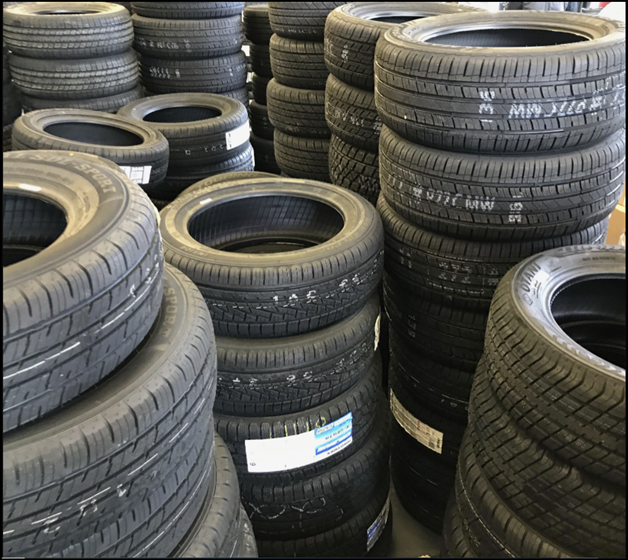How To Prevent Dry Rot When Storing Tires
Bargain Storage
March 30th, 2021

Dry rot is a common type of tire decay where the rubber dries out, becomes brittle, and starts cracking. Once dry rot gets beyond a certain point, the risk of tire blowout becomes so high that need to be replaced. The main causes of dry rot in tires are exposure to certain elements that speed up the degradation and leeching out of resins that keep moisture within a tire. These elements include:
- UV rays from the sun.
- Rapid fluctuations in temperature.
- Excessive humidity or moisture on the surface of the tire.
- Exposure to oxygen and ozone (for this reason a degree of such degradation is inevitable during the lifespan of the tire).
You can tell whether a tire is beginning to develop dry rot by looking out for the following signs:
- The tire becomes harder and brittle to the touch, starting to feel more like leather than rubber.
- Tires become faded, appearing more gray than black, even after they are washed
- Cracks start to appear in a tire’s tread and sidewall.
Example of a dry rotted tire with cracks on the tread Dry rot is particularly prevalent in tires that are stationary for a long period of time. This is because the moisture within a tire is maintained by resins that are activated when a tire is in motion. While long-term vehicle storage does increase the chances of dry rot occurring in tires, there are steps that you can take to reduce the chances of your tires deteriorating in this way while in storage. Here are these steps:
Protecting your tires before you store your vehicle
Clean your tires thoroughly before they go into storage
The vital oils and resins in tires can be slowly stripped away from the evaporation of mud and other debris on the rubber. Therefore you should clean your tires thoroughly before storing a vehicle.
While you can buy specialist tire cleaners, we would strongly recommend not using them if you are planning to keep tires in storage. These cleaners are specially designed to be used on tires that are regularly in motion, and the petroleum in them can speed up the process of dry-rotting. Instead, just use warm water with a small amount of detergent to clean your tires.
Be mindful of the age and condition of tires before they go into storage
Older tires are more prone to developing dry rot than newer tires. This because the resins that prevent dry rot in tires naturally leech out over time, leaving them with less protection.
It therefore might not be the best idea to put a vehicle with tires over five years old into longer-term storage. Storage already speeds up the deterioration of tires, and it could spell the end of the lifespan of tires that reach this age. Tires should be replaced after six years anyway, so the road-worthiness of a tire that has both five years of use and which has been in long-term storage should be assessed by a professional.
You can tell the age of a tire by looking at the final numbers on the inside layer of a tire’s sidewall. Image source: https://www.bmwofstratham.com/how-to-read-tire-size-stratham-nh/ Storing your vehicle with its older tires on with a view to replacing the tires as soon as the vehicle comes out of storage can be a smart way of completely negating the effects of any deterioration caused by such storage.
Preventing dry rot when your vehicle is in storage
Make sure that your stored vehicle is not in direct sunlight
The three biggest causes of dry rot in tires are dampness, exposure to UV, and oxidisation. Keeping your stored vehicle and tires outside of direct sunlight is therefore imperative to reduce the chances of tires developing dry rot. The ability to block out UV rays is one of the biggest advantages of specialized vehicle storage units over keeping your vehicle in outdoor long-term parking. If you cannot keep your vehicle out of direct sunlight, then it’s worth buying a dark car cover to physically block UV rays.
Long-term storage of free tires to prevent dry rot
Tires can become susceptible to dry rot even if they are not on your vehicle. Here are some ways to prevent dry rot in spare and replacement tires that are kept in storage.
Store Tires In Airtight Bags
Dampness and oxidization bring on dry rot in tires. Therefore tires should be stored in airtight, waterproof bags. While specialized tire bags do exist, they can be expensive (often as much as $30 per bag). Any thick plastic contractor bag should be adequate to store a tire in. If you can try to store tires in individual bags to prevent them from rubbing against each other.
Conclusion: Proper storage of tires should save you money in the long run
Preventing dry rot in tires is all about keeping them out of environments that may expose them to heat, excessive moisture or dryness, or oxygen. While this may involve paying a little extra for climate control storage units, this cost should be offset by avoiding maintenance or replacement costs of your tires when your vehicle comes out of storage.
Storage Tips & Local News | Bargain Storage Blog
